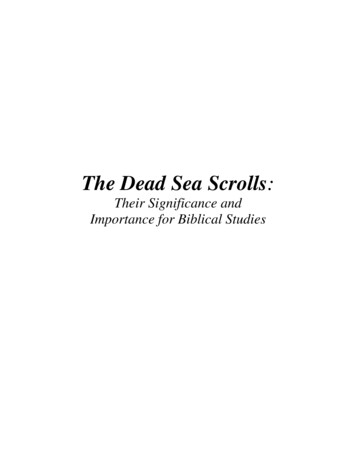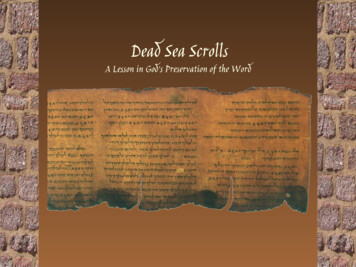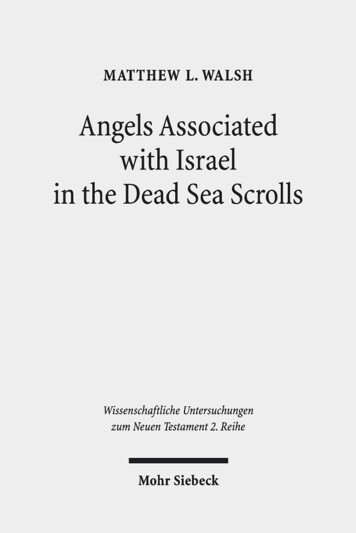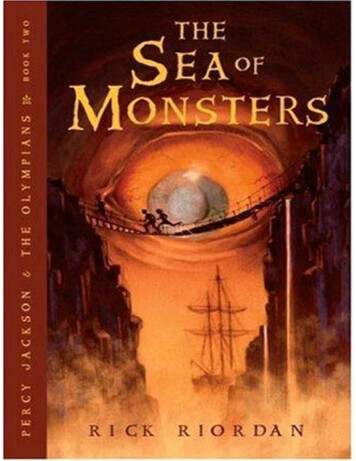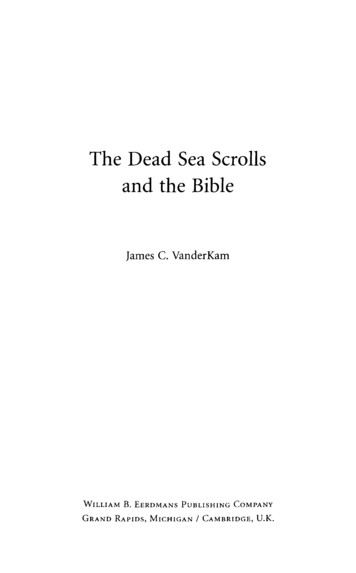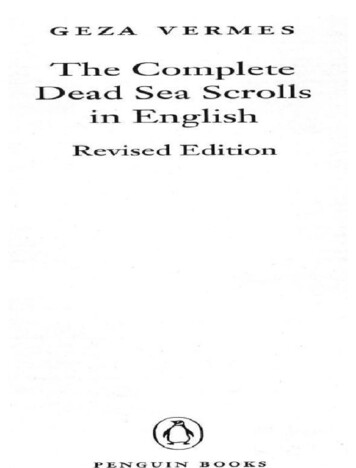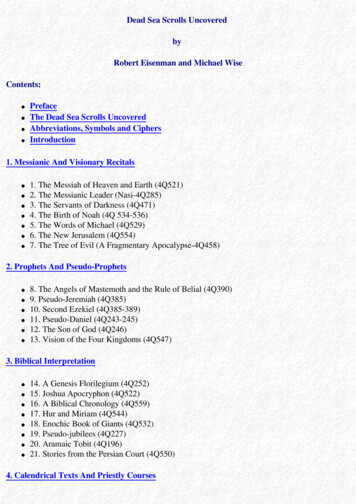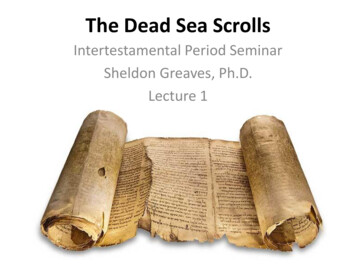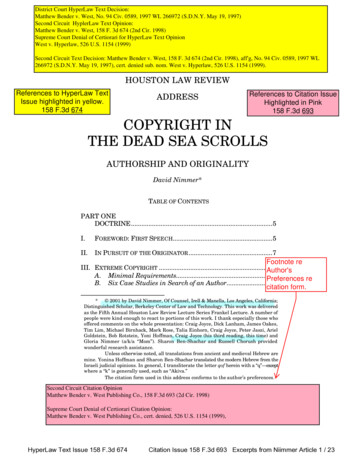
Transcription
District Court HyperLaw Text Decision:Matthew Bender v. West, No. 94 Civ. 0589, 1997 WL 266972 (S.D.N.Y. May 19, 1997)Second Circuit HyplerLaw Text Opinion:Matthew Bender v. West, 158 F. 3d 674 (2nd Cir. 1998)Supreme Court Denial of Certiorari for HyperLaw Text OpinionWest v. Hyperlaw, 526 U.S. 1154 (1999)Second Circuit Text Decision: Matthew Bender v. West, 158 F. 3d 674 (2nd Cir. 1998), aff'g, No. 94 Civ. 0589, 1997 WL266972 (S.D.N.Y. May 19, 1997), cert. denied sub. nom. West v. Hyperlaw, 526 U.S. 1154 (1999).HOUSTON LAW REVIEWReferences to HyperLaw TextIssue highlighted in yellow.158 F.3d 674ADDRESSReferences to Citation IssueHighlighted in Pink158 F.3d 693COPYRIGHT INTHE DEAD SEA SCROLLSAUTHORSHIP AND ORIGINALITYDavid Nimmer*TABLE OF CONTENTSPART ONEDOCTRINE.5I.FOREWORD: FIRST SPEECH.5II.IN PURSUIT OF THE ORIGINATOR .7Footnote reIII. EXTREME COPYRIGHT .14Author'sA. Minimal Requirements.14Preferences reB. Six Case Studies in Search of an Author.16citation form.* 2001 by David Nimmer, Of Counsel, Irell & Manella, Los Angeles, California;Distinguished Scholar, Berkeley Center of Law and Technology. This work was deliveredas the Fifth Annual Houston Law Review Lecture Series Frankel Lecture. A number ofpeople were kind enough to react to portions of this work. I thank especially those whooffered comments on the whole presentation: Craig Joyce, Dick Lanham, James Oakes,Tim Lim, Michael Birnhack, Mark Rose, Talia Einhorn, Craig Joyce, Peter Jaszi, ArielGoldstein, Bob Rotstein, Yoni Hoffman, Craig Joyce (his third reading, this time) andGloria Nimmer (a/k/a “Mom”). Sharon Ben-Shachar and Russell Chorush providedwonderful research assistance.Unless otherwise noted, all translations from ancient and medieval Hebrew aremine. Yonina Hoffman and Sharon Ben-Shachar translated the modern Hebrew from theIsraeli judicial opinions. In general, I transliterate the letter qof herein with a “q”—exceptwhere a “k” is generally used, such as “Akiva.”The citation form used in this address conforms to the author’s preferences.Second Circuit Citation OpinionMatthew Bender v. West Publishing Co., 158 F.3d 693 (2d Cir. 1998)1Supreme Court Denial of Certiorari Citation Opinion:Matthew Bender v. West Publishing Co., cert. denied, 526 U.S. 1154 (1999),HyperLaw Text Issue 158 F.3d 674Citation Issue 158 F.3d 693 Excerpts from Niimmer Article 1 / 23
44HOUSTON LAW REVIEW[38:1IV.TO THE MIDDLE EAST FROM WEST[F]aithfulness to the public-domain original is thedominant editorial value, so that the creative is theenemy of the true.Judge Dennis Jacobs163The Dead Sea Scrolls, although frequently invoked as anemblem for ancient revelation,164 actually show up in only oneU.S. copyright case. The case is Bender v. West.165 Although ittreats copyright in the context of CD-ROMs containing judicialopinions, this opinion actually evinces a good deal of overlap withthe case of the Dead Sea Scrolls, Qimron v. Shanks.166For over a century, West has been the premier reporter ofjudicial decisions within the United States. Though it serves asofficial reporter of only a few jurisdictions, for most of the twentiethcentury it constituted the de facto reporter for all federal courtdecisions, and those of many states as well.167 In a common lawsystem, the law of the land is contained in judicial systems. Thosejudicial opinions themselves, according to ancient authority, are notsubject to copyright,168 no matter how creative the judges mightCitation Case #1163. Matthew Bender & Co. v. West Publ’g Co., 158 F.3d 674, 688 (2d Cir. 1998), cert.denied, 526 U.S. 1154 (1999).164. Previous references in U.S. case law to the scrolls used them as an archetype fora blockbuster revelation:Since 1983, no new information has come to light that would make thiscourt better informed about the intent of the 1871 Congress than the SupremeCourt was informed in 1983. The legislative-history equivalent of the Dead SeaScrolls has not been discovered or called to our attention.Lyes v. City of Riviera Beach, 166 F.3d 1332, 1352–53 (11th Cir. 1999) (footnote omitted)(en banc) (Edmondson, J., concurring in part and dissenting in part). See also Joel D.Berg, The Troubled Constitutionality of Anti Gang Loitering Laws, 69 CHI.-KENT L. REV.461, 469 n.61 (1993) (“[M]any laws are incomprehensible to many lawyers; laypersonsmay just as well try and translate the Dead Sea Scrolls rather than waste their timetrying to figure out what the law either commands or forbids.”).165. 158 F.3d 693 (1998), cert. denied, 526 U.S. 1154 (1999). Along with mycolleagues Morgan Chu, Elliot Brown, and Perry Goldberg, I represented Matthew Benderagainst West Publishing Company at all three court levels.166. Refer to Chapter V infra.167. See L. Ray Patterson & Craig Joyce, Monopolizing the Law: The Scope ofCopyright Protection for Law Reports and Statutory Compilations, 36 UCLA L. REV. 719,727 n.21 (1989). See also 1 F. Cas. iii (1894) (West refers to itself as “the official reporterof the federal courts”); Garfield v. Palmieri, 193 F. Supp. 137, 143 (S.D.N.Y. 1961), aff’d,297 F.2d 526, 527–28 (2d Cir. 1962) (holding a judge’s forwarding of the court’s opinion toWest for publication immune from liability as part of the judge’s official duties).168. Callaghan v. Myers, 128 U.S. 617, 661–62 (1888); Banks Law Publ’g Co. v.HyperLaw Text Issue 158 F.3d 674Text Case #1Citation Issue 158 F.3d 693 Excerpts from Niimmer Article 2 / 23
2001]45DEAD SEA SCROLLShave been in crafting their words.169 Thus, a researcher in, say,1985, although free under copyright law to access judicial opinionsanywhere, as a practical matter could do so only through theinstrumentality of West’s reporters. West’s product as of that datewas not only nonpareil but also effectively unchallenged by anycompetitor.West successfully excluded competitors from the field via anearly skirmish held in 1986.170 Despite the harsh criticism that thatdecision attracted,171 it provided West with a litigation juggernautthat lasted for over a decade. Then, legal publisher Matthew Bender& Company decided to take on West by publishing on CD-ROM itsown rival compilation of cases, some indirectly derived from West’sreporters. Bender included references to West pagination in its CDROM, inasmuch as that pagination is required to cite cases tocourts and in legal scholarship. In addition, Bender included whatcan be termed “the textus r eceptus of judicial opinions,” which is themanner in which West publishes them in its quasi-official reporters.Bender filed for declaratory relief that it did not violate West’scopyright in the process.172At base, Bender v. West presented two copyright issues forresolution. First, conceding that the judges’ opinions themselveswere not subject to protection, West claimed copyright in thepagination of its case reporters.173 Second, West claimedcopyright in emendations to the opinions themselves.174 IfLawyers’ Coop. Publ’g Co., 169 F. 386, 390–91 (2d Cir. 1909), appeal dismissed, 223 U.S.738 (1911). Cf. Wheaton v. Peters, 33 U.S. (8 Pet.) 591, 613 (1834) (finding law reports“objects of literary property”). See also West Publ’g Co. v. Mead Data Cent., Inc., 799 F.2d1219, 1239 (8th Cir. 1986) (Oliver, J., dissenting in part). On the early practices in theUnited States of judicial reporting, leading up to Wheaton v. Peters, see Craig Joyce, TheRise of the Supreme Court Reporter: An Institutional Perspective on Marshall CourtAscendancy, 83 MICH. L. REV . 1291 (1985).169. From the beginning, judges have expended tremendous creativity in the task ofjudicial interpretation. See generally Susanna L. Blumenthal, Law and the Creative Mind,74 CHI .-K ENT L. REV . 151 (1998). Nonetheless, that type of creativity, like the creativitythat goes into a scientific breakthrough, has never warranted copyright protection. Referto Case 6 (The Atom) supra; Case 14 (Fermat) supra.170. West Publ’g Co., 799 F.2d at 1222.171. See, e.g., Monopolizing the Law , supra note 167, upon which the Supreme Courtrepeatedly relies in Feist.172. Another legal publisher, HyperLaw, intervened as a party plaintiff to vindicatea similar claim. The companion cases discussed below arose from West’s losses to Benderand HyperLaw, respectively.173. Matthew Bender & Co. v. West Publ’g Co., 158 F.3d 674, 695 (2d Cir. 1988), cert.denied, 526 U.S. 1154 (1999). Note that the custom of pagination goes back to antiquity.Between Volumen and Codex, supra note 146, at 88. Use of Arabic numerals for thispurpose dates back to 1516. THE PRINTING PRESS AS AN AGENT OF CHANGE , supra note 17,at 106 n.202.174. Bender, 158 F.3d at 677.Citation Case #2Text Case #2HyperLaw Text Issue 158 F.3d 674Citation Issue 158 F.3d 693 Excerpts from Niimmer Article 3 / 23
46HOUSTON LAW REVIEW[38:1accepted, West’s copyright claim would prevent Bender andothers from producing usable case compilations on CD-ROM.Before explicating the legal issues, it is necessary to excludefrom consideration the uncontroversial aspects of West’scopyright. All parties admitted for purposes of the litigation thatWest enjoyed copyright protection over its case reporters as awhole, insofar as those volumes include syllabi authored by West,summarizing the holdings of each case; key numbers, by whichWest categorized individual components of those cases;headnotes that West generated, encapsulating each holdingrepresented by a key number; and other ancillary material, suchas tributes and prefaces at the beginning of individual volumesand indices at the end of those volumes. The nub of thedisagreement between the parties concerned the following:?Pagination. Except for very short opinions, the text of anygiven case begins on one page and then continues, frompage to page, across the reporter. Citations to opinions,by practice and individual court order,175 must be to theparticular page in which the cited proposition occurs; forexample: 171 F.2d 318, 320. West contended thatreprinting public domain judicial opinions, along with anotation as to where the subject break occurred in theWest reporters—in the foregoing example, of the form“*320”—violated West’s pagination st“massages” those opinions in various ways. Thus, thefinal text of an opinion as it appears might containnumerous differences from the way that the judgeauthored it. For instance, the judge might refer to “FeistPub. v. Rural Tele. Co., 499 U.S. 340 (1990).” When thereference appears in a West case reporter, it could beprinted in the following format: “Feist Publications, Inc.v. Rural Telephone Service Co., 499 U.S. 340, 113 L. Ed.2d 358, 111 S. Ct. 1282 (1990).” Again, by practice andindividual court order, quotations to opinions must be inthe latter formulation.176In addition, courts do not collect names of attorneys. Westincludes information as to attorney names. Of necessity, Westchooses, among various options, how to present the names of175. See, e.g., 3D CIR. R. 28.3(a). For a catalog of many such local rules, seeMonopolizing the Law , supra note 167, at 727 n.21.176. It is for that reason that West’s emendations effectively constitute the “textusreceptus of judicial opinions,” as claimed above.HyperLaw Text Issue 158 F.3d 674Citation Issue 158 F.3d 693 Excerpts from Niimmer Article 4 / 23
2001]DEAD SEA SCROLLS47counsel. In terms of subsequent history of cases and in otherallied respects, West also adds features to its reporters.177The Second Circuit denied West’s claims in two companionopinions.178 Those opinions explicate copyright’s standard for“originality” as requiring “that the work result from ‘independentcreation’ and that the author demonstrate that such creationentails a ‘modicum of creativity.’”179 The former simply meansthat the work was not copied from a prior source.180 The lattermeans that certain works, notwithstanding the absence ofcopying, are too banal to warrant copyright protection.181As to star page numbers corresponding to the breaks inpagination in West’s reporters, the Second Circuit relied onWest’s concession that the page breaks in its reporters wereinserted by computer, applying rote methodology, rather thanthrough the exercise of any human creativity. The court alsocited an alternative rationale, discussed below.182As to the various alterations that West imbued into thejudicial opinions, the court conceded that the threshold forcreativity is low in order to achieve copyright protection, “even inworks involving selection from among facts.”183 Nonetheless, evenText CaseText Case #4Text Case #5177. The emendations are slightly more complicated than the foregoing summary. Assummarized by the Second Circuit, West claims originality in the followingenhancements:?The format of the party names—the “caption”—is standardized by capitalizingthe first named plaintiff and defendant to derive a “West digest title,” andsometimes the party names are shortened (for example, when one of theparties is a union, with its local and national affiliations, West might give#3only the local chapter number, and then insert “etc.”).?The name of the deciding court is restyled. For example, West changes the slipopinion title of “United States Court of Appeals for the Second Circuit” to“United States Court of Appeals, Second Circuit.”?The dates the case was argued and decided are restyled. For example, whenthe slip opinion gives the date on which the opinion was “filed,” Westchanges the word “filed” to “decided.”?The caption, court, docket number, and date are presented in a particularorder, and other information provided at the beginning of some slip opinionsis deleted (such as the lower court information, which appears in the Westcase syllabus).Bender, 158 F.3d at 683 (footnote omitted).178. Id. at 674, 693.179. Id. at 681 (emphasis in original).180. Key Publ’ns, Inc. v. Chinatown Today Publ’g Enters., 945 F.2d 509, 512–13 (2dCir. 1991). Illustrative here would be Marklund’s forgery and Charlie’s copying of A Taleof Two Cities. Refer to Cases 11–12 (Doppelgänger, Forgery) supra.181. Feist itself exemplifies that phenomenon. Note that these two ingredients arelabeled originality and creativity in Chapter II in fine supra.182. Refer to Chapter VII, section (A)(2) infra.183. Bender, 158 F.3d at 689.Text Case #6HyperLaw Text Issue 158 F.3d 674Citation Issue 158 F.3d 693 Excerpts from Niimmer Article 5 / 23
48HOUSTON LAW REVIEW[38:1in those cases, the Second Circuit limited copyright protection to“evaluative and creative” works, in which the compiler exercises“subjective judgments relating to taste and value that were notobvious and that were not dictated by industry convention.”184These considerations neither deny the value of West’s casereporters nor the praise due their compilers. The court concludedas follows:West’s editorial work entails considerable scholarly laborand care, and is of distinct usefulness to legal practitioners.Unfortunately for West, however, creativity in the task ofcreating a useful case report can only proceed in a narrowgroove. Doubtless, that is because for West or any othereditor of judicial opinions for legal research, faithfulness tothe public-domain original is the dominant editorial value,so that the creative is the enemy of the true.185The Second Circuit drops a footnote at this point containingtwo citations. The first is to a case that counsel for Bender citedboth to the district court and Second Circuit.186 The second didnot come from any brief submitted by the parties;187 instead,Judge Jacobs alighted on it independently:Text Case #7Text Case #8On the other hand, preparing an edition from multipleprior editions, or creating an accurate version of themissing parts of an ancient document by using conjecture todetermine the probable content of the document may take ahigh amount of creativity. See, e.g., Abraham Rabinovich,Scholar: Reconstruction of Dead Sea Scroll Pirated, Wash.Times: Nat’l Wkly. Edition, Apr. 12, 1998, at 26 (discussingscholar’s copyright infringement claim in Israeli SupremeCourt relating to his reconstruction of the missing parts of a“Dead Sea Scroll” through the use of “educated guesswork”based on knowledge of the sect that authored work).188Of course, the remark constitutes obiter dictum. Nonetheless, itis interesting that the sole reference in any reported decision inthe United States to Qimron v. Shanks occurs in this context.Text Case #9184. Id.185. Id. at 688. The quotation should be recalled in the context of Qimron’s claim toprotection by virtue of the extent of scholarly labor that he expended on 4QMMT. Refer toChapter VIII infra.186. Bender, 158 F.3d at 688 n.13, citing Grove Press, Inc. v. Collectors Publication,Inc., 264 F. Supp. 603 (C.D. Cal. 1967) (holding that even 40,000 changes made to a work,in the form of correcting punctuation and typographical errors and the like, stand outsidecopyright protection).187. As noted above, this writer represented Bender. Refer to note 165 supra.188. Bender, 158 F.3d at 688 n.13.Text Case #10HyperLaw Text Issue 158 F.3d 674Citation Issue 158 F.3d 693 Excerpts from Niimmer Article 6 / 23
2001]DEAD SEA SCROLLS49In any event, West applied to the Supreme Court for a writof certiorari.189 The denial of that petition means that Bender v.West now stands as res judicata.189. West filed its petition for certiorari while I was living in Jerusalem. ElliotBrown finished drafts of our opposition every night, which was morning my time when hee-mailed it to me, where I worked on the draft while he slept, only to continue the processthe next day.While we were preparing the opposition, our client made a surprising decision—to join in the certiorari petition, asking the Supreme Court to affirm summarily andthereby end once and for all West’s “scarecrow copyright” by which it had chasedcompetitors out of the field. Thus, the “opposition” that we ultimately filed with theSupreme Court actually joined in West’s request for review.Completing the surrealism, West vitriolically attacked our non-opposition. Butthe matter ended when the Supreme Court refused to hear the matter.HyperLaw Text Issue 158 F.3d 674Citation Issue 158 F.3d 693 Excerpts from Niimmer Article 7 / 23
2001]DEAD SEA SCROLLS97VII.MIND BENDERThe study of the Dead Sea Scrolls is and hasalways been neither theology nor science but anexercise in almost pure religious metaphor.Neil Silberman471There are many levels on which to confront the copyrightlessons of Qimron v. Shanks. The previous chapter looked at someof the particulars animating that controversy, leading to casespecific applications of such doctrines as fair use and uncleanhands. The present chapter, by contrast, proceeds on a moreuniversal level. As a way of examining authorship and the properbounds of copyright protection, this chapter takes lessons from theSecond Circuit’s Bender v. West case, applying them to the generalenterprise of scholars seeking copyright protection in theirreconstruction of ancient scrolls. These considerations thus applynot only to Elisha Qimron himself, but across the board to all whoseek to reconstruct old texts, regardless of the circumstances.A. Fact/Expression DichotomyText Case #11West, like the scholars of the Dead Sea Scrolls, labored in adomain in which “faithfulness to the public-domain original isthe dominant editorial value.”472 The same considerations thatdoomed West’s copyright likewise forestall Qimron’s claim. TheSupreme Court’s standard in Feist (the “telephone book whitepages” case) governs here: “[C]opyright assures authors the rightto their original expression, but encourages others to build freelyupon the ideas and information conveyed by a work. Thisprinciple, known as the idea/expression or fact/expressiondichotomy, applies to all works of authorship.”473In Bender v. West, the Second Circuit invoked thefact/expression dichotomy to find such copying as occurred on the471.472.473.THE HIDDEN SCROLLS, supra note 190, at 50.Matthew Bender & Co. v. West Publ’g Co., 158 F.3d 674, 688 (2d Cir. 1998).Feist Publ’ns, Inc. v. Rural Tel. Serv. Co., 499 U.S. 340, 349–50 (1991).As applied to a factual compilation, assuming the absence of originalwritten expression, only the compiler’s selection and arrangement may beprotected; the raw facts may be copied at will. This result is neither unfair norunfortunate. It is the means by which copyright advances the progress of scienceand art.Id.HyperLaw Text Issue 158 F.3d 674Citation Issue 158 F.3d 693 Excerpts from Niimmer Article 8 / 23
98HOUSTON LAW REVIEW[38:1safe side of the line.474 Star pagination merely conveysunprotected information.475 By the same token, any copying ofQimron’s manuscript reconstruction, as opposed to histranslation of MMT or his commentary thereon, is similarlynonactionable. For it represents, pure and simple, the facts as tohow TR expressed himself 2,000 years ago, reproduced asfaithfully as Qimron was capable of achieving.1. Originalitya. Quantum of OriginalityAt the outset, a distinction must be acknowledged. Bender v.West held that the page numbers at issue there contained nocopyrightable expression whatsoever, having been rotely insertedby a computer.476 Qimron, by contrast, labored for eleven years toreproduce 4QMMT. Thus, the factors that animated the court inBender v. West could be argued to actually safeguard Qimron’sprotection.Moreover, it may be conceded that Qimron reconstructed4QMMT differently than any other would have done. Whatgreater proof of originality could there be than thedistinctiveness of his contribution?We turn first to that last consideration. Then, the discussionwinds back to whether, in the ultimate analysis, Bender v. Westfavors Qimron’s position.Citation Case #3b. “Distinctive” Does Not Translate to “Original”Does copyrightable originality follow from the fact thatQimron’s reconstruction was unique to him—that no otherhuman being on earth would have put the bits and pieces ofmanuscript together in exactly the same way (assuming that tobe the case)? Properly construed, distinctiveness does not equateto copyrightable expression.Both Bender v. West and Feist bear out that proposition. Inthe former case, there is no doubt that the particular case474. In a profound sense, there is a subjective element even in the most “objective”fact. “Nature states no ‘facts’: these come only within statements devised by humanbeings to refer to the seamless web of actuality around them.” O RALITY AND LITERACY,supra note 1, at 68. Facts themselves “have no necessary stable existence, but arethemselves texts.” Robert H. Rotstein, Beyond Metaphor: Copyright Infringement and theFiction of the Work, 68 CHI .-K ENT L. REV . 725, 769 (1993). However true in the noumenalrealm, these considerations are too metaphysical for the pragmatic concerns animatingthe law. Refer to Part Two infra.475. Bender, 158 F.3d at 701.476. Refer to Case 17 (The Bingo Cards) supra.HyperLaw Text Issue 158 F.3d 674Citation Issue 158 F.3d 693 Excerpts from Niimmer Article 9 / 23
2001]DEAD SEA SCROLLS99reporters produced by West were unique to it. No othercompetitor, left to its own devices, would ever develop a singlevolume, let alone a whole series, identical to any book of theFederal Reporter (i.e., containing the same page numberdivisions, the same citation methodology, the same attorneynames presented in the same format, etc.). Yet the SecondCircuit ruled that those factors, despite their distinctiveness, lieoutside copyright protection.An even stronger application of this principle emerges from theSupreme Court’s ruling that copyright protection is lacking in thewhite pages of a telephone book.477 In the first place, a telephonecompany must assign a unique phone number to e ach user (just asWest must assign a unique page number to each page). Thatprocess itself can be complex.478 Moreover, that phone number, likeWest’s page numbers, is not an “antecedent fact”; it springs intoexistence only by virtue of the putative property owner’s labor.479Yet those circumstances by themselves do not confer copyrightstatus.Moreover, each phone book directory containingalphabetized white pages itself represents a profoundly uniquecompilation, reflecting innumerable choices by its creator.Consider a simple thought experiment.?In a town live 1,000 individuals whose names have beencollected from time immemorial in standard alphabeticalorder. To the town now move ten strangers—Axelaus der Mühlen,480 Sharon Ben Shachar,481 Chou EnLai, 482 the artist formerly known as Prince,483 and diverse477. Refer to Case 5 (The Phonebook) supra.478. See WHO O WNS INFORMATION?, supra note 283, at 39.479. “A telephone number is not like a mathematical algorithm or law of nature thatlies waiting to be discovered . . . .” Id.480. Which name should be treated as his surname? Should it go by capitalization?Or by order?481. As an initial matter, should the letter chet in her name be transliterated as“Shachar” or “Shahar.” Next, should this entry come after surnames such as Benshein? Ordoes the space mean that it should come before?482. Axel, the German’s first name, is also his given name; but Chou, the Chinese’sfirst name, is his family name, not his given name. (Using the appellation “Christianname” instead of “given name” even more starkly highlights the value judgments at playhere.)483. That individual has been no stranger to copyright litigation. See Paisley ParkEnters., Inc. v. Uptown Prods., 54 F. Supp. 2d 347, 348–49 (S.D.N.Y. 1999) (issuing anorder preventing Prince’s videotaped deposition from being exploited on defendants’ Website). In Pickett v. Prince, 52 F. Supp. 2d 893, 896 (N.D. Ill. 1999), aff’d, 207 F.3d 402 (7thCir. 2000), a fan created a guitar in the shape of Prince’s symbol/name. Because the fanappropriated that copyrighted image without authorization, he was denied copyright inhis product, by application of the rule confronted above that is relevant to Qimron as well.HyperLaw Text Issue 158 F.3d 674Citation Issue 158 F.3d 693 Excerpts from Niimmer Article 10 / 23
100HOUSTON LAW REVIEW[38:1members of the same Irish clan (who were split up uponentry to Ellis Island and who therefore spell their namesdifferently): McCormick, MacCormick, M’Cormick,McOrmick, MacOrmick, Maccormick, and Mac Cormick. Ahundred employees of the telephone company produce ahundred distinctive lists when attempting to integrate justthose ten names. 484?Of course, the chore of compiling a phone book does notend there. In addition to deciding how to alphabetize“nonstandard” names, a value judgment also must bemade as to where to draw the boundaries. One couldchose the municipality of Beverly Hills; or the entireregion of West Los Angeles, including Beverly Hills (orexcluding it!); or South Beverly Hills alone; or SouthBeverly Hills together with Beverlywood; or SouthBeverly Hills, Beverlywood, and the Pico-Robertsonneighborhood; or South Beverly Hills, extending all theway to Century City; or South Beverly Hills extendingto Century City, but stopping at Century Park East; etc.From these considerations, it should be evident that almostlimitless patterns are available. Indeed, one could imagine thepossibility of producing as many different white-pages directoriesfor communities of the United States as there are theoreticallypermutations for bingo cards.485 The fact that any phonedirectory produced by a given individual is unique and distinctiveto her and would match the phone directory produced by no otherindividual does not by itself vouchsafe the existence of copyrightprotection. For Justice O’Connor, speaking on behalf of aunanimous Supreme Court, has told us that all alphabetizedwhite-page directories stand outside copyright protection.2. Literary Work vs. Material ObjectWe return to the argument that Bender v. West, by excludingfrom protection the page breaks rotely inserted by computer,favors copyright for 4QMMT, which required eleven years ofQimron’s painstaking labor to produce. For this purpose, it isRefer to Chapter VI, section (B)(2) supra. The district court’s discussion of the doctrine ofunauthorized exploitation is one of the most elaborate of any case. Pickett, 52 F. Supp. 2dat 901–09 & n.17 (relying on NIMMER ON COPYRIGHT, the “treatise[] cited ubiquitously asauthority in copyright cases”).484. Humans quite obviously work according to different criteria than themechanistic ones programmed into a computer, as anyone trying to access a ponderouslynamed Web site can attest. See David Nimmer, Puzzles of the Digital MillenniumCopyright Act, 46 J. COPYRIGHT SOC’Y 401, 450 n.236 (1999).485. Refer to Case 17 (Bingo Cards) supra.HyperLaw Text Issue 158 F.3d 674Citation Issue 158 F.3d 693 Excerpts from Niimmer Article 11 / 23
2001]DEAD SEA SCROLLS101necessary to advert to a more evanescent facet of Bender v. West.This particular aspect did not even occur to me throughoutpreparing and replying to the cross-motions for summary judgmentin the district court. In fact, we had already prevailed in a finaljudgment below and were brain-storming about the appellate briefbefore becoming aware that we had been ignoring the fact thatWest’s whole claim to pagination copyright rested on conflating a“fundamental distinction” of copyright law. We therefore arguedthis new basis to the Second Circuit, which adopted it as analternative basis.486 (West, meanwhile, did not even try to addressour new theory, directly or obliquely, in its reply brief—from whichwe inferred that no answer was possible.)Turning to that “fundamental distinction,” the legislativehistory tells us that it pertains between a copyright and thematerial object in which it is embodied.487 Th
The Dead Sea Scrolls, although frequently invoked as an emblem for ancient revela. 164tion, actually show up in only one U.S. copyright case. The case is . Bender v. West. 165. Although it treats copyright in the context of CD-ROMs containing judicial opinions, this opinion actually evinces a good deal of overlap with the case of the Dead Sea .
